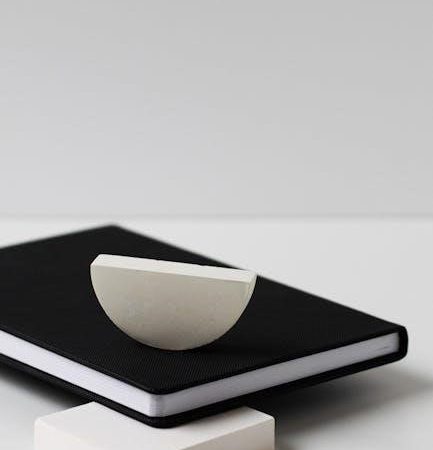Chaplet of the Precious Blood⁚ A Comprehensive Guide
Explore the profound devotion of the Chaplet of the Precious Blood, a powerful prayer focusing on the seven principal sheddings of Jesus’s blood. Discover its origins, the seven mysteries contemplated, associated promises, and detailed instructions for prayer. Learn about its spiritual significance and personal testimonies. This guide provides a comprehensive understanding of this enriching Catholic practice.
Origins and History of the Chaplet
The precise origins of the Chaplet of the Precious Blood remain somewhat obscure, lacking the extensive historical documentation found with other established Catholic devotions like the Rosary. While various sources mention its appearance in the late 20th century, particularly within specific communities, a definitive historical account tracing its inception to a single individual or event is unavailable. Some accounts link its dissemination to a young Nigerian teenager, Barnabas Nwoye, to whom it was allegedly revealed by Our Lord himself. This narrative emphasizes the Chaplet as a “last and greatest devotion of our time,” bestowed with numerous promises. However, verification of this origin story requires further scholarly investigation. Regardless of its precise origins, the Chaplet has gained popularity as a devotion centered on the profound significance of Christ’s sacrifice and the power of His Precious Blood. The lack of extensive historical records hasn’t diminished its spiritual impact on those who practice it.
The Seven Mysteries of the Precious Blood
The Chaplet of the Precious Blood centers on meditating upon seven key moments in the life of Jesus Christ where His Precious Blood was shed. While specific names or titles for these mysteries may vary across different versions or traditions, the core focus remains consistent. These mysteries typically include the Agony in the Garden, the Scourging at the Pillar, the Crowning with Thorns, the Carrying of the Cross, the Crucifixion, the Piercing of His Side (the Longinus wound), and the Blood shed throughout His Passion. Each mystery offers a profound opportunity for contemplation on the immense love and sacrifice of Jesus, His suffering for humanity’s redemption, and the transformative power of His Precious Blood. The devotional practice encourages a deeper understanding of the sacrifice and its significance in Christian faith. Through focused reflection, believers can experience a renewed sense of gratitude and devotion to Christ.
Promises Associated with the Chaplet
Numerous promises are attributed to Jesus Christ for those who devoutly pray the Chaplet of the Precious Blood. These promises, often found in various texts and traditions surrounding the devotion, highlight the spiritual benefits and divine protection associated with its practice. While the exact wording may differ across sources, common themes emerge. These often include protection from evil attacks, safeguarding of the five senses, and preservation from sudden death. Some accounts also mention a promise of receiving grace and spiritual strength, a strengthening of faith, and the assurance of God’s presence and guidance in times of trial. It’s crucial to remember that these promises are understood within the context of faith and personal relationship with God. The Chaplet is seen as a means of deepening this relationship and opening oneself to God’s grace, rather than a guarantee of specific material outcomes. The true value lies in the spiritual growth and closeness to Christ fostered through prayer.
How to Pray the Chaplet of the Precious Blood
The Chaplet of the Precious Blood typically utilizes a rosary or a string of beads, often with 33 beads representing the 33 years of Jesus’ life, divided into seven sets of five Our Fathers, each followed by seven Hail Marys. Begin with the invocation of the Holy Spirit, followed by a brief opening prayer. Each set of beads corresponds to one of the seven mysteries of the Precious Blood, meditating on a specific event where Jesus shed His blood. After each mystery, five Our Fathers are recited, followed by seven Hail Marys, and a Glory Be to the Father. The final set may vary, sometimes concluding with three Our Fathers instead of five. Throughout the prayer, focus on contemplating the sacrifice of Jesus, His love for humanity, and the significance of His Precious Blood. Closing prayers, such as a litany to the Precious Blood or a personal prayer of thanksgiving, are commonly included. The specific wording and order of prayers can vary depending on the tradition followed; therefore, it is advisable to consult a reliable resource for a detailed and accurate guide to praying the Chaplet.
Variations and Related Devotions
Explore related devotions such as the Rosary and Litany of the Precious Blood, discovering similarities and differences in their prayers and spiritual focus. Learn about Novenas and other prayers dedicated to the Precious Blood of Jesus Christ.
Comparison with Other Devotions (e.g., Rosary)
While both the Chaplet of the Precious Blood and the Rosary are Marian devotions utilizing beads for prayer, key distinctions emerge. The Rosary centers on the life of Mary and the mysteries of the faith through her lens, invoking her intercession. In contrast, the Chaplet of the Precious Blood directly focuses on the sacrifice of Jesus Christ, meditating on the shedding of His Precious Blood at seven key moments. The Rosary often incorporates the Hail Mary, while the Chaplet of the Precious Blood features prayers directly addressing the Precious Blood and its significance. The structure differs as well; the Rosary’s consistent pattern of Hail Marys and Our Fathers contrasts with the Chaplet’s distinct structure of seven sets of prayers for each mystery. Although both practices offer opportunities for contemplation and prayer, their thematic and structural differences highlight unique pathways to spiritual growth and devotion. The Rosary’s focus on Mary’s life and role in salvation complements the Chaplet’s emphasis on Christ’s sacrifice, enriching the spiritual experience for those who practice both devotions. While both utilize the repetition of prayers for meditative purposes, the Chaplet’s emphasis on the Precious Blood offers a distinct perspective on Christ’s sacrifice and its redemptive power, setting it apart from the broader focus of the Rosary. Each provides a unique avenue for spiritual contemplation and connection with the divine.
Litany of the Precious Blood
The Litany of the Precious Blood, often used in conjunction with the Chaplet, is a powerful form of prayer dedicated to honoring and invoking the merits of Jesus’s sacrifice. This litany typically consists of a series of invocations and responses, praising and imploring the Precious Blood for various graces and blessings. Common invocations include “Precious Blood of Jesus Christ, save us,” and “Precious Blood of Jesus Christ, cleanse us.” The Litany often calls upon the Blood of Christ to heal, protect, and sanctify individuals and the world. It serves as a potent reminder of the immense power of Christ’s sacrifice, emphasizing its redemptive and sanctifying effects. Unlike the Chaplet’s structured meditation on specific mysteries, the Litany offers a more fluid and expansive expression of adoration and supplication. This flexibility allows for personal reflection and heartfelt petitions, making it a versatile prayer for individual or communal use. The Litany can be prayed independently or incorporated into other devotional practices, enriching the experience of prayer and deepening one’s connection with the sacrifice of Jesus. The repetitive structure of the Litany, similar to other liturgical forms, fosters a contemplative atmosphere and enhances the meditative quality of the prayer. It’s a testament to the enduring power and significance of the Precious Blood in Christian faith and devotion.
Novenas and Prayers Related to the Precious Blood
Beyond the Chaplet itself, numerous novenas and other prayers enrich the devotion to the Precious Blood of Jesus Christ. These devotional practices often center on specific intentions or petitions, leveraging the power and efficacy of Christ’s sacrifice. Novenas, nine-day prayer cycles, are particularly common, allowing for focused intercession and sustained spiritual engagement. These might focus on healing, protection, conversion, or other spiritual needs. Many individuals find solace and strength in these extended periods of prayer, believing in the potent intercession of the Precious Blood. Alongside novenas, various other prayers exist, ranging from short invocations to longer litanies. These prayers often incorporate themes of adoration, repentance, and petition, echoing the central message of the Precious Blood’s redemptive power. Some prayers may emphasize specific aspects of the Passion, such as the scourging at the pillar or the crucifixion itself, while others focus on the overall significance of Christ’s sacrifice for humanity’s salvation. These diverse prayer forms offer believers various pathways to connect with the profound spiritual reality of the Precious Blood. The use of these supplemental prayers alongside the Chaplet can deepen one’s devotion and enhance the spiritual benefits received. The common thread running through all these prayers is the unwavering faith in the transformative power of Christ’s sacrifice and the hope for divine grace.
Spiritual Benefits and Significance
Praying the Chaplet offers profound spiritual growth, fostering deeper faith and devotion to Christ’s sacrifice. It provides solace, peace, and a strengthened connection with God’s grace, leading to personal transformation and spiritual enrichment.
Theological Significance of the Precious Blood
The theological significance of the Precious Blood within the Chaplet centers on its role in salvation history. The shedding of Christ’s blood is understood as the ultimate act of love and sacrifice, the fulfillment of the Old Testament prophecies, and the means by which humanity is redeemed from sin. The Eucharist, where the sacrifice is perpetually renewed, highlights the ongoing efficacy of the Precious Blood. The blood symbolizes the new covenant established between God and humanity, a bond sealed through Christ’s death and resurrection. This covenant promises forgiveness, reconciliation, and eternal life to those who believe and receive God’s grace. The devotion emphasizes the profound mystery of God’s love, manifest in the willingness to endure suffering and death for the sake of humanity’s salvation. Through the contemplation of the Precious Blood, believers are called to a deeper understanding of Christ’s sacrifice and its transformative power in their lives. The Chaplet offers a structured way to meditate on this pivotal aspect of Christian theology, deepening faith and strengthening the bond with the divine.
Personal Testimonies and Experiences
While the provided text doesn’t offer specific named personal testimonies regarding the Chaplet of the Precious Blood, the numerous mentions of its existence and popularity strongly suggest a wealth of personal experiences among its devotees. Anecdotal accounts likely circulate within Catholic communities, sharing stories of answered prayers, spiritual comfort, and deepened faith attributed to this devotion. These experiences likely center on themes of protection from harm, spiritual guidance, and a sense of closeness to Christ. The feeling of receiving God’s grace and mercy through the meditation on the sacrifice of Jesus is a common thread in such accounts. The Chaplet’s structure, designed for repetitive prayer and reflection, likely fosters a personal connection with Christ’s suffering and love. The promises associated with the Chaplet, while not empirically verifiable, may contribute to a sense of divine assurance and protection among those who pray it. These unspoken, personal stories represent a crucial aspect of the Chaplet’s enduring appeal, forming a living tradition alongside its historical and theological significance.

